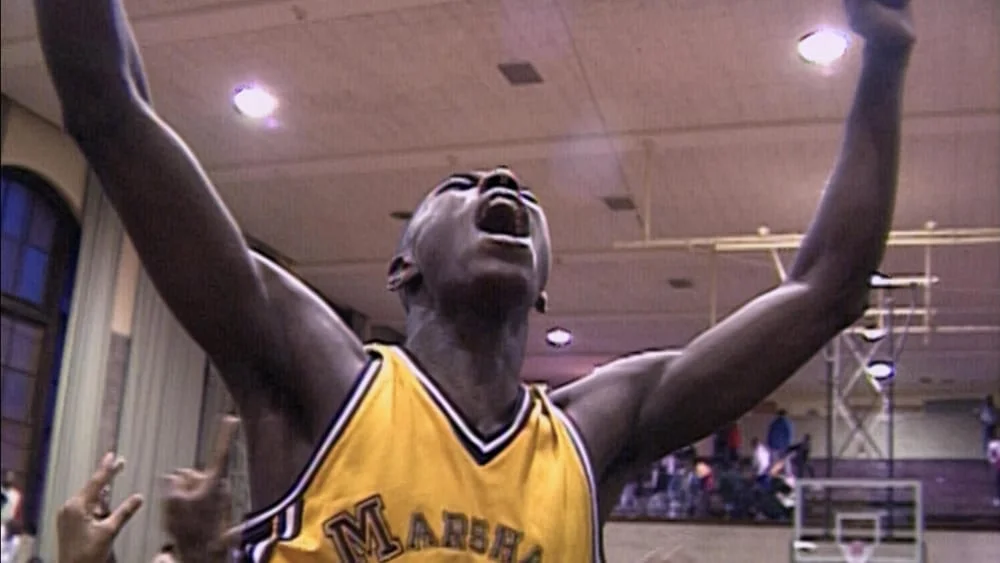“Hoop Dreams” is the blueprint for any great sports film. We may be drawn to the story by our love of basketball and want to see the associated successes, failures, comebacks, highlights, and championships, but we can get that from following live sports on TV. Narrative films, fiction or non-fiction, should never put sports at the center. The sport should be an extension of the larger story the filmmakers want to tell. A context needs to be created to help us understand the cultural importance of these silly little games and what that says about people, cities, and even nations. In taking this approach, “Hoop Dreams” is not about two kids trying to become professional basketball players. Instead, it is a film about the American Dream, the fallacy of that dream, and the way Americans remain optimistic despite that.
In America, if you want something and work hard enough to get it, you will have the opportunity to have it — or at least be rewarded in some way for all of your efforts. By now, I think we all know this is bullshit. There are too many factors out of a person’s own control that determine what happens to them for it to be true. There is some good in the hopeful idealism of the American Dream. We hope that we live in a meritocracy and that everyone eventually gets what they deserve. By holding onto the fantasy, hope does not evaporate from the hearts and minds of those left behind by bad luck and systemic oppression.
But we must still contend with the fact that no matter how much you want something and how hard you pursue it, your success isn’t up to you. That’s not to say we don’t have any agency. William Gates and Arthur Agee do everything in their power to put themselves in a position to succeed. Gates takes advantage of his early talent to solidify a starting spot on the varsity team, catching the eye of some major college scouts in the process. Agee is more of a project at the start of his high school career, but the potential is clearly there for a great coach to untap, and he works hard to show what he’s capable of. Unrealistic though their NBA dreams might be just from a statistical standpoint (especially given that they’re both undersized guards), their end goals aren’t that far-fetched. But both are derailed by problems neither boy could do anything about. The coaching staff at St. Joseph’s isn’t willing to take on the project that Agee presents, and unlike other Freshman project players, Agee’s family can’t afford to keep him around and let him try to prove himself to the staff. For Gates, he has the clearest path of all to achieve his highest ambitions, but an ill-timed knee injury takes away whatever NBA athleticism he had to start with. These are crushing revelations because we know barriers like these are unavoidable. They have done everything right to live their American Dream, and it doesn’t matter. The dream is deferred.
But these kids never give up hope. It’s part of what makes them so endearing but also so relatable. They maintain the sort of mass delusion that infects most Americans — they feel they are the best, and their lives should reflect that. As they mature, you get the sense that these delusions subside (somewhat), but when they have committed so much time and effort to pursuing a specific path, doing anything else doesn’t seem like an option. They must either reckon with the fact that their dreams are quickly crumbling or hope that one day, someone will give them a chance. Like most Americans, they choose to hope. The resilience of their optimism is the only thing that can keep them moving forward. Their dreams will never come true, but that doesn’t mean their situations can’t get better.
More detail isn’t always better. It can be fun for a docuseries to take its time and build out the subjects’ personalities through funny nonsequiturs, but if they aren’t contributing to the film’s core thematic arguments, it can bog things down. But you also can’t have a complete portrait of something without the level of detail a film like “Hoop Dreams” brings. Character-building side stories also fill out the more ambitious exploration of life on the margins of American society. Coming back to the film after seeing it before and knowing how things turn out, each interview and life choice carries greater emotional weight. But there are no surprises in “Hoop Dreams,” and there never have been. That’s why every viewing is so powerful and why it’s so easy to come back to. We’ve seen this story before. It’s universal. And every time, we hope that things work out for these kids and cheer when they succeed. That hope keeps us coming back because, when things look bleak, what else can we do?

